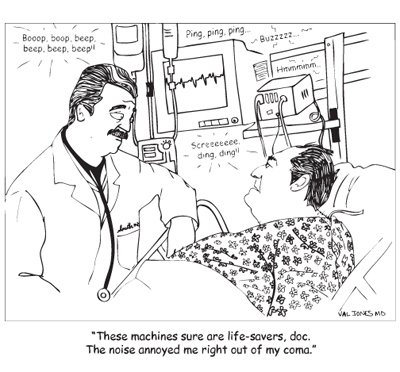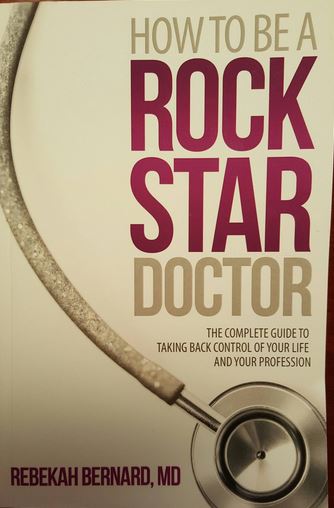May 28th, 2011 by GarySchwitzer in Health Tips
1 Comment »

On the NPR Shots blog, Scott Hensley writes, “Quality Prescription For Primary Care Doctors: Do Less,” about an article in the Archives of Internal Medicine. Excerpt:
“A group of docs who want to improve the quality and cost-effectiveness of primary care tinkered with some Top 5 lists for of dos and don’ts for pediatricians, family doctors and internists.
After testing them a bit, they published online by the Archives of Internal Medicine. Most of the advice falls in the category of less is more.
So what should family doctors not be doing? The Top 5 list for them goes like this:
1. No MRI or other imaging tests for low back pain, unless it has persisted longer than six weeks or there are red flags, such as neurological problems.
2. No antibiotics for mild to moderate sinusitis, unless it has lasted a week or longer. Or the condition worsens after first getting better.
3. No annual electrocardiograms for low-risk patients without cardiac symptoms.
4. No Pap tests in patients under 21, or women who’ve had hysterectomies for non-malignant disease.
5. No bone scans for women under 65 or men under 70, unless they have specific risk factors.”
*This blog post was originally published at Gary Schwitzer's HealthNewsReview Blog*
March 10th, 2011 by Harriet Hall, M.D. in Opinion, Research
No Comments »

A new article in the Journal of Women’s Health by Westhoff, Jones, and Guiahi asks “Do New Guidelines and Technology Make the Routine Pelvic Examination Obsolete?”
The pelvic exam consists of two main components: The insertion of a speculum to visualize the cervix and the bimanual exam where the practitioner inserts two fingers into the vagina and puts the other hand on the abdomen to palpate the uterus and ovaries. The rationales for a pelvic exam in asymptomatic women boil down to these:
- Screening for chlamydia and gonorrhea
- Evaluation before prescribing hormonal contraceptives
- Screening for cervical cancer
- Early detection of ovarian cancer
None of these are supported by the evidence. Eliminating bimanual exams and limiting speculum exams in asymptomatic patients would reduce costs without reducing health benefits, allowing for better use of resources for services of proven benefit. Pelvic exams are necessary only for symptomatic patients and for follow-up of known abnormalities. Read more »
*This blog post was originally published at Science-Based Medicine*
September 10th, 2010 by Peggy Polaneczky, M.D. in Better Health Network, Health Policy, Health Tips, News, Opinion, Research
No Comments »

 The Telegraph reports that the number of screening pap smears performed in the UK has declined after an 8 percent blip upwards in 2009 when publicity surrounding the death of Jade Goody from cervical cancer may have led more women to have this important screening test:
The Telegraph reports that the number of screening pap smears performed in the UK has declined after an 8 percent blip upwards in 2009 when publicity surrounding the death of Jade Goody from cervical cancer may have led more women to have this important screening test:
NHS laboratories processed 415,497 tests in 2009-2010, about 35,000 fewer than the previous year when 450,522. Miss Goody’s death in March last year prompted a 20 percent increase in the number of Scottish women taking tests. More than 122,000 were processed between April and June last year, the statistics revealed.
The irony of course, is that British reality TV star Jade Goody did have pap smears, but chose to ignore her doctor’s recommendations for treatment when her pap smears came back abnormal.
Nonetheless, the decline in pap smears has led NHS of Scotland to initiate a campaign to reach the up to 25 percent of young women who do not respond to invitations to have pap smears. Read more »
*This blog post was originally published at tbtam*
July 28th, 2010 by Davis Liu, M.D. in Better Health Network, Health Policy, News, Opinion, Research
2 Comments »

 The American College of Obstetricians and Gynecologists (ACOG) recently reiterated their position that Pap smears should be performed on healthy women starting at age 21. This is different from the past which recommended screening for cervical cancer at either three years after the time a woman became sexually active or age 21, whichever occurred first.
The American College of Obstetricians and Gynecologists (ACOG) recently reiterated their position that Pap smears should be performed on healthy women starting at age 21. This is different from the past which recommended screening for cervical cancer at either three years after the time a woman became sexually active or age 21, whichever occurred first.
How will the public respond to this change?
Over the past year there have been plenty of announcements from the medical profession regarding to the appropriateness of PSA screening for prostate cancer and the timing of mammogram screening for breast cancer. Understandably, some people may view these changes in recommendations as the rationing of American healthcare. Read more »
*This blog post was originally published at Saving Money and Surviving the Healthcare Crisis*
November 21st, 2009 by Toni Brayer, M.D. in Better Health Network, News
No Comments »

 Right in the middle of the national firestorm about Mammogram recommendations, the American College of Gynecologists (ACOG) has issued new guidelines for screening of cervical cancer. After 40 years of successfully convincing women to get pap smears annually, the new recommendations say women should not get their first pap test until age 21 and the intervals for testing can then be stretched out.
Right in the middle of the national firestorm about Mammogram recommendations, the American College of Gynecologists (ACOG) has issued new guidelines for screening of cervical cancer. After 40 years of successfully convincing women to get pap smears annually, the new recommendations say women should not get their first pap test until age 21 and the intervals for testing can then be stretched out.
The new recommendations say that women should start pap screening at age 21 (not teens who are sexually active as previously recommended) and then every two years through age 29. Women age 30 and over with three negative pap smears can stretch it out for three years. Women over age 65 can stop getting pap tests if their previous tests have been negative. Women who have had a hysterectomy for non-cancer reasons never need a pap smear. Read more »
*This blog post was originally published at EverythingHealth*


















